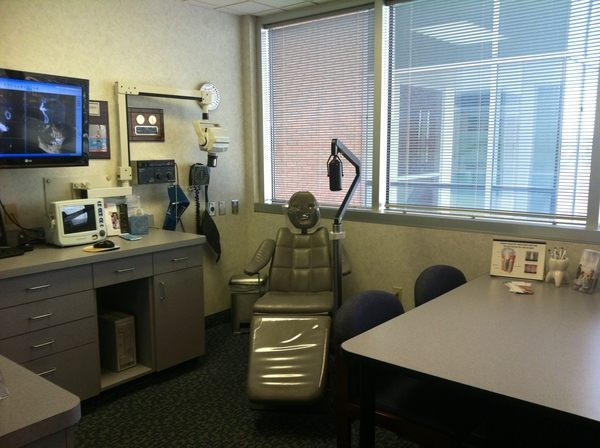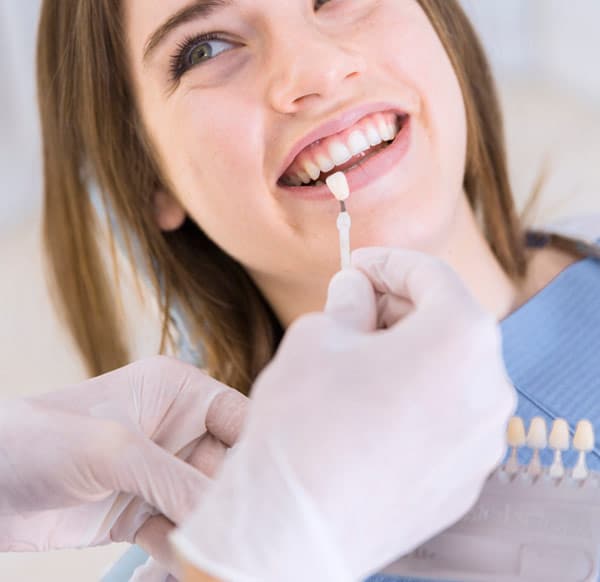Dr.Herpy was born in Painesville, Ohio and raised in Mentor and Kirtland, Ohio. After graduating from Kirtland High School, he went to The Ohio State University where he completed his prerequisites to enter dental school as a junior. He graduated from the O.S.U College of Dentistry in 1987 with honors.
Dr.Herpy was accepted into The United States Air Force Dental Residency Training Program where he trained at Wright Patterson Air Force Base in Dayton, Ohio for one year. He then practiced general dentistry at Grand Forks Air Base in North Dakota for two years.
After being accepted into the oral and maxillofacial surgical residency program at O.S.U in 1989, Dr.Herpy completed his training in June of 1994. Dr.Herpy became Board Certified in 1996.
What are my options if I have missing teeth?
With many state-of-the-art dental treatments and prevention options available in dentistry today, there are fewer reasons for having to extract (remove) teeth. When something does go wrong with a tooth, we try to do everything possible to restore the tooth to its original function. Removing a tooth is the last option because we know that removal may lead to severe and costly dental and cosmetic problems if the tooth is not replaced.
Losing a tooth can be a very traumatic experience and it’s very unfortunate when it does happen. Injury, accident, fracture, severe dental decay, and gum disease are the major reasons for having to remove a tooth. If teeth are lost due to injury or have to be removed, it is imperative that they be replaced to avoid cosmetic and dental problems in the future.
When a tooth is lost, the jaw bone that helped to support that tooth begins to atrophy, causing the teeth on either side to shift or tip into the open space of the lost tooth. Also, the tooth above or below the open space will start to move towards the open space because there is no opposing tooth to bite on. These movements may create problems such as decay, gum disease, excessive wear on certain teeth, and TMJ (jaw joint) problems. These problems and movements do not result immediately, but will eventually appear, compromising your chewing abilities, the health of your bite, and the beauty of your smile.
Options for replacement of missing teeth:
Removable bridges - This type of bridge is a good solution for replacing one or more missing teeth, especially in complex dental situations where other replacement options are not possible. They are usually made of tooth-colored, artificial teeth combined with metal clasps that hook onto adjacent natural teeth. Removable bridges are the most economical option for replacing missing teeth, but may be the least aesthetically pleasing. This is because the metal clasps on the appliances are often impossible to completely conceal.
Fixed bridges - This type of bridge is generally made of porcelain or composite material and is anchored (cemented) permanently to a natural teeth adjacent to the missing tooth site. The benefit of this type of bridge is that it is fixed (not removable) and it is very sturdy. The disadvantage is that in order to create a fixed appliance, two healthy, natural teeth will have to be crowned (capped) to hold the bridge in place.
Dentures - This type of tooth replacement is used when most or all of the natural teeth are missing in one dental arch. Dentures are removable artificial teeth that are made to closely resemble the patients’ original teeth.
Implants - Are a great way to replace one or more missing teeth. They may also be great to support ill fitting dentures. A dental implant is an artificial root that is surgically placed into the jaw bone to replace a missing tooth. An artificial tooth is placed on the implant, giving the appearance and feel of a natural tooth. Implants are very stable, durable, and are the most aesthetically pleasing tooth replacement option.
If you are missing teeth, ask us if they need replacement and what options are available to you. Together we will select the best replacement option for your particular case. Prevention and early treatment is always less involved and less costly than delaying treatment and allowing a serious problem to develop.
What does heart disease and other medical conditions have to do with periodontal (gum) disease?
Many people are unaware that having periodontal disease (the destruction of gum tissue and bone that hold our teeth in place) can affect your overall health. Periodontal disease is one of the most common infections; often more prevalent than the common cold! Periodontal disease is not only the number one reason people lose teeth; it can also affect the health of your body!
Periodontal disease is a bacterial infection, and in its earliest stages, it’s called gingivitis. It starts when an accumulation of plaque (a colony of bacteria, food debris, and saliva) is NOT regularly removed from the gums and teeth. The bacteria in plaque produce toxins/acids that irritate and infect the gums and eventually destroy the jaw bone that supports the teeth. When periodontal disease is not treated it can eventually lead to tooth loss!
There are numerous studies that have looked into the correlation between gum disease and major medical conditions. These studies suggest people with periodontal disease are at a greater risk of systemic disease and indicate that periodontal disease may cause oral bacteria to enter the bloodstream and travel to major organs and begin new infections. Research suggests that periodontal bacteria in the blood stream may:
Contribute to the development of heart disease
Increase the risk of stroke
Compromise the health of those that have diabetes or respiratory diseases
Increase a woman’s risk of having a preterm, low-birth weight baby
Researchers conclude there is still much research to be done to understand the link between periodontal disease and systemic diseases, but enough research has been done to support that infections in the mouth can play havoc elsewhere in the body.
To ensure a healthy, disease-free mouth, we recommend the importance of regular dental check-ups and cleanings, which include a periodontal evaluation. Also, diligent home care and a proper diet can help reduce the plaque and bacteria in the mouth.
Remember….the mouth body connection! Taking care of your oral health may contribute to your overall medical health!
What should I do if a tooth is knocked out?
We’re all at risk for having a tooth knocked out. More than 5 million teeth are knocked out every year! If we know how to handle this emergency situation, we may be able to actually save the tooth. Teeth that are knocked out may be possibly reimplanted if we act quickly, yet calmly, and follow these simple steps:
Locate the tooth and handle it only by the crown (chewing part of the tooth), NOT by the roots.
DO NOT scrub or use soap or chemicals to clean the tooth. If it has dirt or debris on it, rinse it gently with your own saliva or whole milk. If that is not possible, rinse it very gently with water.
Get to a dentist within 30 minutes. The longer you wait, the less chance there is for successful reimplantation.
Ways to transport the tooth
Try to replace the tooth back in its socket immediately. Gently bite down on gauze, a wet tea bag or on your own teeth to keep the tooth in place. Apply a cold compress to the mouth for pain and swelling as needed.
If the tooth cannot be placed back into the socket, place the tooth in a container and cover with a small amount of your saliva or whole milk. You can also place the tooth under your tongue or between your lower lip and gums. Keep the tooth moist at all times. Do not transport the tooth in a tissue or cloth.
Consider buying a “Save-A-Tooth” storage container and keeping it as part of your home first aid kit. The kit is available in many pharmacies and contains a travel case and fluid solution for easy tooth transport.
The sooner the tooth is replaced back into the socket, the greater the likelihood it has to survive and possibly last for many years. So be prepared, and remember these simple steps for saving a knocked-out tooth.
You can prevent broken or knocked-out teeth by:
Wearing a mouthguard when playing sports
Always wearing your seatbelt
Avoiding fights
Avoid chewing hard items such as ice, popcorn kernels, hard breads, etc.
Why is it important to use dental floss?
Brushing our teeth removes food particles, plaque, and bacteria from all tooth surfaces, except in between the teeth. Unfortunately, our toothbrush can’t reach these areas that are highly susceptible to decay and periodontal (gum) disease.
Daily flossing is the best way to clean between the teeth and under the gumline. Flossing not only helps clean these spaces, it disrupts plaque colonies from building up, preventing damage to the gums, teeth, and bone.
Plaque is a sticky, almost invisible film that forms on the teeth. It is a growing colony of living bacteria, food debris, and saliva. The bacteria produce toxins (acids) that cause cavities and irritate and inflame the gums. Also, when plaque is not removed above and below the gumline, it hardens and turns into calculus (tartar). This will further irritate and inflame the gums and also slowly destroy the bone. This is the beginning of periodontal disease.
How to floss properly:
Take 12-16 inches (30-40cm) of dental floss and wrap it around your middle fingers, leaving about 2 inches (5cm) of floss between the hands.
Using your thumbs and forefingers to guide the floss, gently insert the floss between teeth using a sawing motion.
Curve the floss into a “C” shape around each tooth and under the gumline. Gently move the floss up and down, cleaning the side of each tooth.
Floss holders are recommended if you have difficulty using conventional floss.
Daily flossing will help you keep a healthy, beautiful smile for life!
How often should I brush and floss?
Brushing and flossing help control the plaque and bacteria that cause dental disease.
Plaque is a film of food debris, bacteria, and saliva that sticks to the teeth and gums. The bacteria in plaque convert certain food particles into acids that cause tooth decay. Also, if plaque is not removed, it turns into calculus (tartar). If plaque and calculus are not removed, they begin to destroy the gums and bone, causing periodontal (gum) disease.
Plaque formation and growth is continuous and can only be controlled by regular brushing, flossing, and the use of other dental aids.
Toothbrushing – Brush your teeth at least twice a day (especially before going to bed at night) with an ADA approved soft bristle brush and toothpaste.
Brush at a 45 degree angle to the gums, gently using a small, circular motion, ensuring that you always feel the bristles on the gums.
Brush the outer, inner, and biting surfaces of each tooth.
Use the tip of the brush head to clean the inside front teeth.
Brush your tongue to remove bacteria and freshen your breath.
Electric toothbrushes are also recommended. They are easy to use and can remove plaque efficiently. Simply place the bristles of the electric brush on your gums and teeth and allow the brush to do its job, several teeth at a time.
Flossing – Daily flossing is the best way to clean between the teeth and under the gumline. Flossing not only helps clean these spaces, it disrupts plaque colonies from building up, preventing damage to the gums, teeth, and bone.
Take 12-16 inches (30-40cm) of dental floss and wrap it around your middle fingers, leaving about 2 inches (5cm) of floss between the hands.
Using your thumbs and forefingers to guide the floss, gently insert the floss between teeth using a sawing motion.
Curve the floss into a “C” shape around each tooth and under the gumline. Gently move the floss up and down, cleaning the side of each tooth.
Floss holders are recommended if you have difficulty using conventional floss.
Rinsing – It is important to rinse your mouth with water after brushing, and also after meals if you are unable to brush. If you are using an over-the-counter product for rinsing, it’s a good idea to consult with your dentist or dental hygienist on its appropriateness for you.





